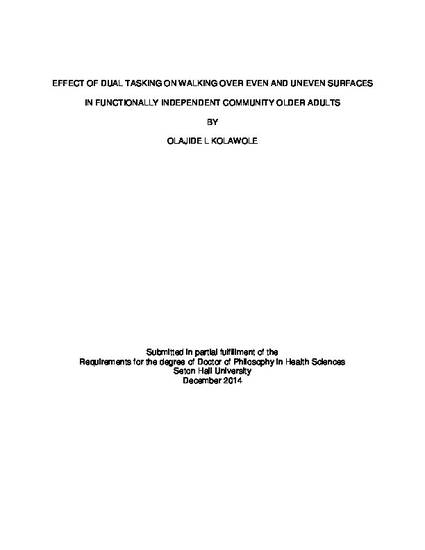
- Dual task,
- Older adults,
- Uneven surface,
- Gait,
- Dual task cost
While several studies have reported a decrement in performance by older adults while walking and concurrently performing a dual task on even surfaces, to date the effects of dual tasking while walking on uneven surfaces commonly found in the community has received less attention. Thus, we sought to test the hypothesis that an incremental decrement in gait parameters will be observed, when walking on an uneven versus an even surface and furthermore, that this decrement would be dependent upon the concurrent performance of a secondary cognitive and/or motor task in functionally independent-living-community older adults.
Dynamic Gait Index assessed the subject’s ability to modify gait in response to changing task demands and Mini Mental State Examination was used to screen cognitive functionof the participants. Twenty-eight participants walked at a comfortable speed over the GAITRiteTM walkway placed over an even and uneven surface. Twenty-four strips of wood measuring 0.10 square meters and 0.05 meter high attached randomly under the smooth surface of an artificial grass mat measuring 6 meter long and 1.2 meter in width simulated a natural uneven surface. Each participant randomly performed a total of three (3) trials each under the following four task conditions as they walked over an even or uneven surface: 1) no secondary task (single task), 2) concurrent cognitive task, 3) concurrent motor task, 4) concurrent cognitive-motor task. The presentation of the task conditions were counterbalanced across subjects. Gait speed, cadence, stride time, and double support time were analyzed using a 2 x 4 repeated measures ANOVA. Also, to quantify subjects' ability for executing two tasks concurrently, we calculated the dual task costs. In addition, the cognitive, motor and cognitive/motor tasks performances on even and uneven surfaces were assessed using Mann-Whitney U.
The results of these analyses revealed significant main effects for concurrent dual-tasking as well as surface for speed [F(1.86,50)= 21.93; p ≤ 0.05; F(1,27)= 24.3, p ≤ 0.05] , cadence [F(1.85,50)=33.824; p ≤ 0.05. F(1,27)= 22.2, p ≤ 0.05], stride time [F(1.94,52.34)= 33.41, p ≤ 0.05; F(1,27)= 23.49, p ≤ 0.05], and double support time [F(1.99,53.62)= 7.4; p ≤ 0.05; F(1,27)= 7.4, p = .011]. It was observed that the elderly slow down, take a lesser number of steps per minute, increase their stride time and spend more time in double support when walking on uneven surfaces and when performing a concurrent dual-task. However, interaction effects failed to achieve significance. This study provides some preliminary evidence that independent, community living older adults use a default strategy that rely on making adjustments in gait that result in greater motor control. In other words the older adults err on the side of safety and focus their anticipatory resources towards controlling balance. It is important for clinicians to be aware of these strategies and incorporate them in the management of the elderly patient.
Available at: http://works.bepress.com/olajide_kolawole/1/